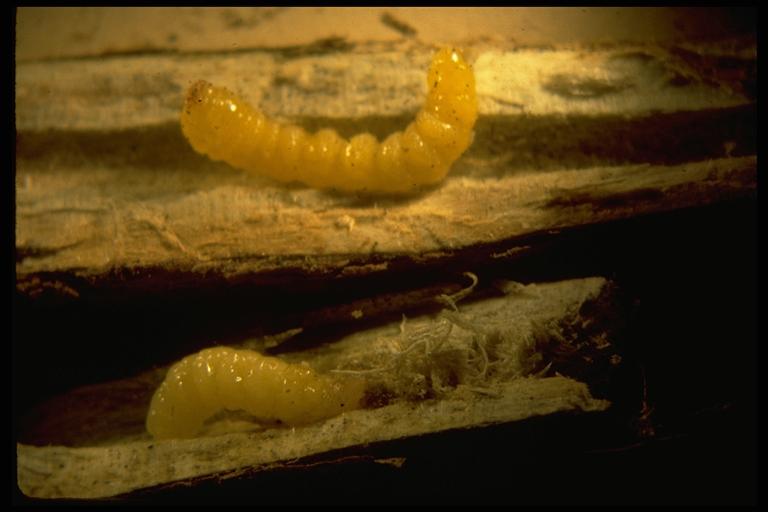
Soybean stem borer, Dectes texanus LeConte (Coleoptera: Cerambycidae), larva. Photo by Drees.
Common Name: Soybean stem borer
Scientific Name: Dectes texanus LeConte
Order: Coleoptera
Description: Larvae (grubs) are creamy white, cylindrical but corrugated and legless, growing up to 5/8-inch long. Adults beetles are roughly ½ inch long, charcoal gray and have antennae that are longer than the body.
Larvae of the lesser cornstalk borer, Elasmopalpus lignosellus (Zeller) (Lepidopera: Pyralidae), also tunnel into the stalks of soybeans and other plants. These active, bluish-green caterpillars have three pairs of true legs behind the head and a series of “false” legs (prolegs) on the abdomen. They are more common in sandier soils along the Texas coast.
Life Cycle: Winter is spent in the larval stage in the stubble of soybeans and other host plants. They pupate in late spring and adults emerge in early summer. Mated females chew crevices along leaf petioles in which they lay eggs. Larvae develop through four stages (instars) in stems of host plants until cold weather begins. There is only one generation per year.
Habitat and Food Source(s): Mouthparts are for chewing. In addition to soybeans, soybean stem borers host plants include cocklebur, ragweed and other weeds. Larvae tunnel through the stem and feed on inner (pith) tissues during July and August, eventually cutting off plants at the base. These plants may fall over (lodge) and become difficult to harvest. This is a particular problem late (September and October) in the growing season. Larvae are apparently cannibalistic, as only one larvae develops per stem. Adults can be found in the spring using a sweep net or at lights at night.
Pest Status, Damage: Larvae tunnel through the stalks of soybeans grown in the Texas panhandle, causing injured plants to fall over (lodge), potentially reducing yield; medically harmless.
For additional information, contact your local Texas A&M AgriLife Extension Service agent or search for other state Extension offices.
Literature: Carter et al. 1982. Drees & Way 1988. Little 1963.